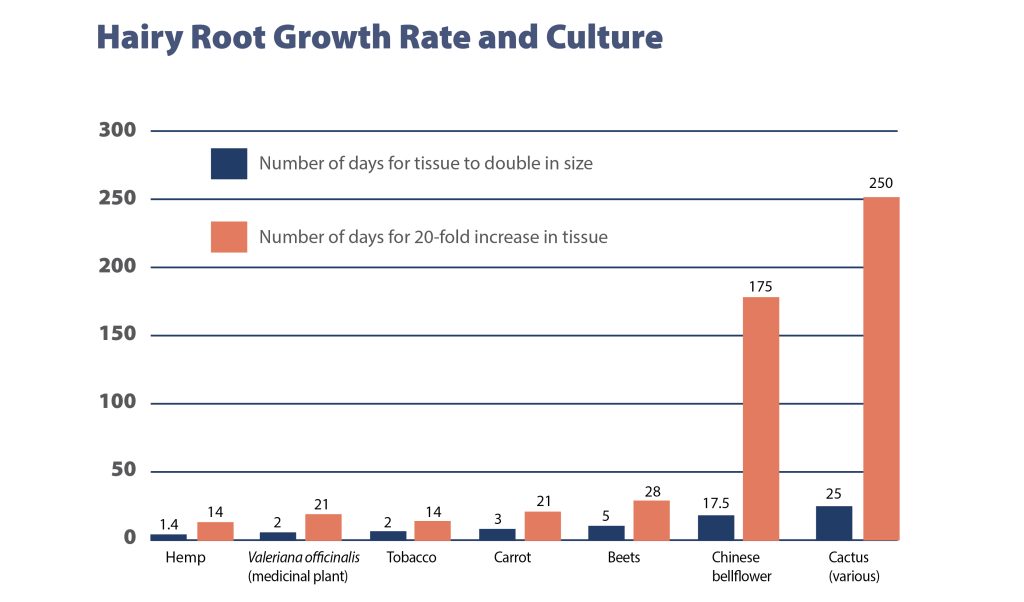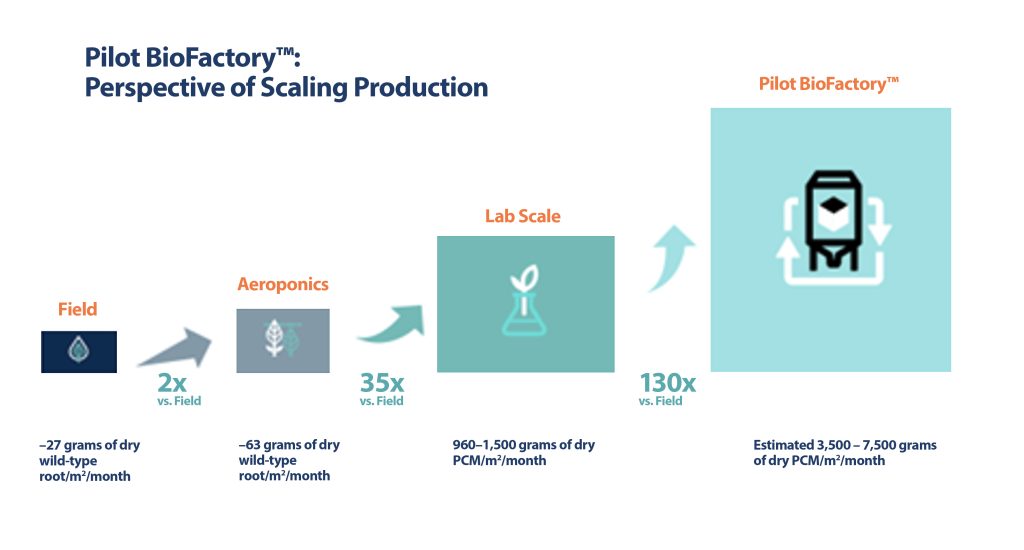Plants are powerful. They have shaped the environments and atmosphere in which all organisms grow and evolve. From the earliest days of multicellular life, plants have synthesized the base nutrients for nearly all existence. They led the move from marine to terrestrial life, and they created and sustain the chemical ecology in which all life on Earth is embedded.
Besides providing the building blocks necessary for other organisms to develop and evolve, plants evolve as well. Indeed, plants have adapted to occupy almost all inhabitable environments. About 400,000 plant species are known, and more are being discovered every year.1

To survive and thrive in diverse and often challenging environmental niches, plants have evolved a monumental array of chemistries. For example, there are chemistries that help plants coordinate their internal processes, as well as chemistries that help plants communicate with their neighbors. The chemical universe of plants is estimated to be in the millions of unique metabolites,2 which dwarfs the chemical spaces that have been established by animals and microbes. Furthermore, many compounds are unique to specific lineages of plants. In short, tapping the diverse power of plants means accessing the diversity of the whole plant kingdom.
Yet over time, as humans domesticated plants to produce more of our needs, we have focused our use of plants on a limited number of high-producing species. For example, about 40% of human-consumed calories come from just three plant species, every one of which comes from the same family of grasses.3 While this success was necessary for feeding an ever-growing human population on limited land resources and continues to be critical for society today, one cannot help but wonder what more could plants offer if we were able to grow all the various species in the world and harness the millions of natural compounds these naturally rich chemical engineers can produce?
Until just recently, this question was nearly impossible to answer because of limited land and seemingly unlimited plant species. Many of the rich chemistries that we have come to use in our daily lives were originally sourced from plants. For example, we have long used saponins in natural soaps. (More recently, we started developing saponin-based adjuvants to enhance immune responses to vaccines.) Salicin from willow bark once served as a pain medication. (Eventually, medicinal salicin was replaced by a related compound known as acetylsalicylic acid, or aspirin.) And an extract from the bark of the Pacific yew was used by Native Americans to treat various ailments. (Today, it is a natural source of Taxol, a powerful anticancer drug.)

Plants are expected to contain many other useful compounds. However, these compounds can be hard to identify. Even after these compounds have been found, they can remain underutilized due to paucity of pathway knowledge, limited natural sourcing, lack of suitable plant production, or the inability to chemically synthesize complex compounds. These challenges are being tackled by Calyxt, a “plant-based synthetic biology company” headquartered in Roseville, MN.
An evolving plant company
Founded in 2010, Calyxt began its synthetic biology journey by engineering the metabolic activity of plants through gene editing. This work reflected what was and remains the company’s driving mission: developing sustainable plant-based solutions that improve health and reduce waste. One of Calyxt’s earliest achievements was the development of a gene edited soybean plant that produces a soybean oil that is higher in oleic acid and lower in saturated fatty acids than commodity soybean oils. Calyxt’s soybean oil is also notable for having zero grams of trans fat per serving.
Finally, it has up to three times the fry life and a longer shelf life than commodity oils—features that enhance sustainability. In subsequent years, Calyxt has built a powerful engine for metabolic design in plants called the PlantSpring™ platform.
Intent on discovering and verifying product concepts and on bringing plant-derived products to market more quickly, Calyxt developed its Plant Cell Matrix™ (PCM™) technology. This technology, which augments the PlantSpring platform, leverages multiple cell types and sustains a transformable and rapidly growing plant organ culture. The culture incorporates structures commonly known as hairy roots and is capable of prototyping metabolic perturbations (Figure 1).

Given their transformation efficiency and productivity, PCM systems are amenable to the regulation of gene expression by various means, including transgene approaches, gene silencing, gene activation, and genome editing. Accordingly, PCM systems allow Calyxt to design, engineer, and discover plant pathways in months—work that ordinarily requires years of whole crop field testing. Calyxt has found that PCM systems are useful not only for testing genetic hypotheses, but also for producing many of the plant metabolites that are desirable for industries such as cosmetics, nutraceuticals, and pharmaceuticals.
Tapping plant potential
Plants are inherently related through evolution of their DNA from common ancestors. This relatedness also means that the chemistries that arise from DNA also share common precursors. As a result, if you can understand the metabolic pathways that exist in one plant and the underlying DNA of those pathways, you can harness that knowledge to produce those chemistries in a different plant beginning with those common precursors.
Of the approximately 400,000 known plant species, only about 800 have had their genomes sequenced.4 Few of the genes that direct the synthesis of plant metabolites are known. Nonetheless, the known plant genome universe is expanding thanks to basic research. At the same time, Calyxt is conducting strategic genome sequencing to elucidate high-value pathways.
The PlantSpring platform combines the tools of public and proprietary genome resources with artificial intelligence/machine learning (AI/ML) to build predictive models that illuminate pathway knowledge across the plant kingdom. Calyxt is addressing one of the known limitations of accessing the diversity of plant-produced biomolecules by leveraging the PlantSpring platform and developing an ecosystem that can make predictions to complete uncharacterized biosynthetic pathways.
The key to eliminating the difficulties of sourcing rare plant material is by advancing PCM systems for the rapid prototyping of metabolic engineering designs. There is a wide variation in the growth rate of PCM systems across plant species. Specifically, hemp produces among the fastest growing hairy roots measured to date (Figure 2).5–10

Beyond biomass accumulation, PCM systems also open the possibility of reproducing biosynthetic pathways from uncultivated and/or endangered plants. Hemp, for example, produces a rich set of precursor chemistries11 that can be modified to produce complex and species-specific secondary metabolites. This enables decoupling of the chemical diversity of plants from the geographical diversity of their ecological niches. In short, compounds from exotic plants could be produced even in locations where the plants are not native.
A final limitation to tapping the potential of plant-produced chemistry is the lack of suitable production systems at scale. Currently, most plant-based biomass production scalability comes as a secondary stream from field crops. Accessing biomolecules is often opportunistic based on the endogenous chemistry of the limited species in production agriculture. PCM design and engineering can enable bespoke biomolecule production, and PCM growth rates augur well for bioproduction scaleup.
Calyxt was able to engineer not only the DNA of the PCM, but also create a system capable of growing PCM systems in a bioreactor. Since bioreactors are enclosed controlled environments, they can be placed anywhere and can grow plants year-round, and they can be built vertically to optimize the growing potential of a limited land area. PCM systems that produce plant-derived compounds can be orders of magnitude more productive per unit land area than field or aeroponics-sourced material (Figure 3). Growing plants in these types of systems is not trivial, but Calyxt believes it has discovered a path to do this with the BioFactory™ production system.

Nature and value of plant chemistry
Plant chemistry systems, especially those responsible for secondary metabolism, are often modular. There are major families of chemistry derived from common precursors, but the individual compounds often reflect the specificity of the species and their environments.
The compounds in the monoterpene, sesquiterpene, and triterpene families are all derived from isoprene subunits. Compounds from any of the families can be modified to produce linear or cyclic skeletons that can be decorated with different functional groups to produce thousands of different compounds. For example, both sterols and saponins are subfamilies within triterpenes that have value in pharmaceutical/medicinal, cosmetics, and industrial applications. However, many triterpenes are either difficult to source or are produced by chemical synthesis using petroleum-based compounds.
By combining a knowledge of chemistry with deep pathway knowledge and engineered PCM systems, Calyxt is working to evolve society’s relationship with plants. Calyxt intends to access previously inaccessible plant chemistries, unlocking the richness therein and delivering countless boons to humanity.
Travis Frey, PhD, serves as chief technology officer and Bobby Williams, PhD, is product engineering director at Calyxt.
References
1. Christenhusz and Byng. The number of known plants species in the world and its
annual increase. Phytotaxa 2016; 261(3): 201–217.
2. Fang et al. Exploring the Diversity of Plant Metabolism. Trends Plant Sci. 2019;
24(1): 83–98.
3. Food and Agricultural Organization of the United Nations. Once neglected, these
traditional crops are our new rising stars. Published: October 2, 2018. Accessed:
September 12, 2022. https://www.fao.org/fao-stories/article/en/c/1154584/.
4. Sun et al. Twenty years of plant genome sequencing: achievements and challenges. Trends Plant Sci. 2022; 27(4): 391–401.
5. Barba-Espin et al. Ethephon-induced changes in antioxidants and phenolic compounds in anthocyanin-producing black carrot hairy root cultures. J. Exp. Bot. 2020;
71(22): 7030–7045.
6. Carlin et al. Effects of different culture media and conditions on biomass production of hairy root cultures in six Mexican cactus species. In Vitro Cell. Dev. Biol.-Plant.
2015; 51(3): 332–339.
7. Häkkinen et al. Molecular farming in tobacco hairy roots by triggering the secretion of a pharmaceutical antibody. Biotechnol. Bioeng. 2014; 111(2): 336–346.
8. Parkin-Parizi et al. Impact of different culture media on hairy roots growth of
Valeriana officinalis L. Acta Agric. Slov. 2014; 103(2): 299–305.
9. Thimmaraju. Bioreactor for cultivation of red beet hairy roots and in situ recovery
of primary and secondary metabolites. Eng. Life Sci. 2009; 9(3): 227–238.
10. Urbanska et al. The growth and saponin production of Platycodon grandiflorum
(Jacq.) A. DC. (Chinese bellflower) hairy roots cultures maintained in shake flasks
and mist bioreactor. Acta. Soc. Bot. Pol. 2014; 83(3): 229–237.
11. Jin et al. Secondary Metabolites Profiled in Cannabis Inflorescences, Leaves,
Stem Barks, and Roots for Medicinal Purposes. Sci. Rep. 2020; 10: 3309.

